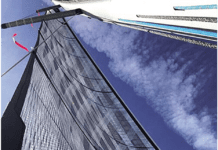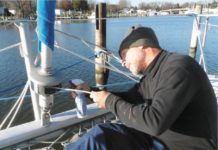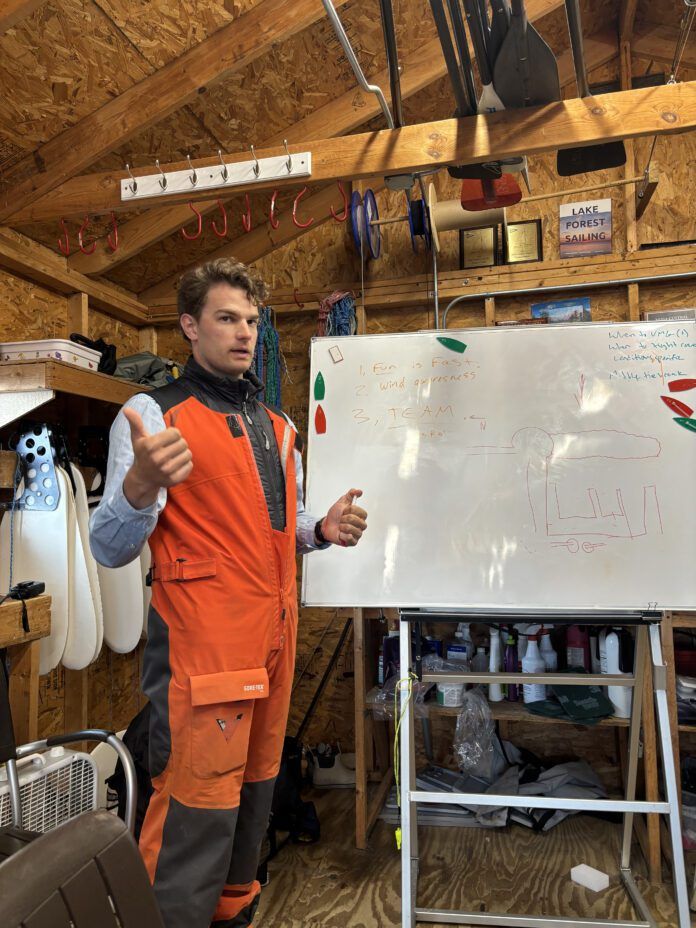I think of sailing as a lifelong pursuit. Mastery of sailing is elusive, there is always more to learn, from leading a new position on a boat you’re familiar with, to learning how to perform maintenance on a part or system on your vessel, there are always more ways to improve your knowledge. For example, once you learn how to sail a symmetrical spinnaker, you can then learn how to sail an asymmetrical spinnaker. While you may know your home waters and weather systems, as you sail in more locations you will always be learning about the local tides and weather patterns around the world.
My sailing education and growth in the sport is hopefully lifelong. So far, I’ve experienced a time of immense growth followed by a longer stretch perfecting and building confidence. I have also stumbled in my sailing development. These stumbles have led to recovery, and I have come out better for it. I have benefited from great instructors and mentors and learned from my own mistakes as an instructor and teacher. After years of sailing, I have picked up many lessons, some etched more brilliant than others.
PATIENCE FOR THE LONG ROAD
In looking back at how I became a sailor, there are several instances where I learned tremendous amounts in a short period of time. These are usually followed by a year of refining this new information. I went from a youth sailor who was confident in dinghy sailing, to racing on larger boats, then getting in to cruising and passage making.
In your journey, you may be comfortable cruising with friends so your next step is building enough confidence to skipper your own boat. That jump can seem daunting but if taken in small steps it’s manageable. For me, I was fortunate to be in a community youth sailing program where I learned and competed in small dinghies. I remember being so excited as a young sailor learning how to tack and rig a boat, and for many years after that initial foray into sailing, I perfected those skills.
It was not until years later when I stepped in to sail a Farr 40. It was a Wednesday night race in the summer, and while the basic fundamentals of the boat and race were the same, the mechanics were drastically different. Spinnakers that I was familiar with now required extensive amounts of rigging to hoist poles, the jib no longer simply had a sheet, instead crew were adjusting jib sheet trimming positions. Then when we started the race, I was overwhelmed with the tactics and maneuvering around the course.
At this point, I had only raced windward leeward or triangle courses so I got off the boat inundated with information. It would be another four years before I competed in the North America championship regatta for the same fleet of 40-ft. boats that I initially sailed in that Wednesday night race. In those four years, I raced on several keel boats over 40 ft., trying to perfect the systems and better understand what goes into making a knowledgeable sailor and someone who can add value to a crew.
ASK QUESTIONS

The path from learning a new sailing skill to gaining mastery of that skill or technique has not been easy and is usually time consuming. This is not unique to sailing. My first time applying varnish left much to be desired. Similarly, as I built my proficiency on larger keel boats, I quickly realized if I wanted to be more then movable ballast or the strong guy to hoist sails, I would need to start learning some more casual skills.
I went about this by asking lots of questions. From rigging in the morning at the dock to talking through maneuvers with the bowman and foredeck team. I watched other boats on the water to understand how similar boats were tuning to adjust to changing conditions. Not asking questions and not being open to learning would have stagnated my sailing education. I would not have accomplished a fraction of the things I have been able to in this sport had I not asked questions.
GO BEYOND YOUR COMFORT ZONE

During times when I felt challenged and pushed myself to join a new crew or learn a new skill, I was never isolated in a silo. In these instances, I was able to learn from professional sailors, people who work in the maritime industry, coaches and experienced boat owners. One of the best pieces of advice I received came from a professional sailor who was on our crew for a regatta. While sitting on the rail of the boat he said, “Learn your position, then learn the position ahead and behind.” If you are trimming jib on a boat, start trying to learn the position ahead of you on the foredeck and start paying attention to what’s going on behind you. Larger crews present more specialized roles and more to learn in each role.
Focusing on one crew position at a time broke down the learning process for me. Always asking questions going into maneuvers or debriefing after a day on the water helped me learn operations and procedures for more complex maneuvers. This lead to a greater sense of confidence because I knew all of the tasks that go in to executing flawless maneuvers.
KNOW YOUR LEARNING STYLE
I have benefitted greatly from the people and boats I have been around. They have not only taught me to be a better sailor but improved my ability to be a teacher. When I began coaching, if someone struggled with a concept, I would often pass the buck saying things like, “It will make more sense when we’re on the water.” However, instead of things becoming more clear on the water, this rushed explanation usually resulted in dropping tillers in maneuvers, boats getting out of control and students struggling to master skills. I knew I could do better.
To more clearly communicate, I walked through lessons on the dock so students could see the vessel and controls, drew diagrams in the classroom so students could see the maneuver or skill from a third person perspective, and walked students through the maneuver with me at the helm or in a critical position prior to learning a new skill. Slowing down and making sure all students understood what was coming next led to a much better experience on the water.
There appear to be two types of students I have sailed with:analytical and artistic. Engineers, architects and people in the sciences seem to pick up on topics in the classroom like wind angles much faster, while more humanity-minded people, like doctors, lawyers and authors, seem to struggle a bit more grasping where wind is coming from and how to set sails appropriately in the classroom.
If you’re a doctor who loves driving by the compass and knows your tacking angles, I mean no offense. As I continued teaching, I started making videos and would review tape prior to heading out for a lesson to show students what crews do during tacks on a variety of boats. Like a sports team watching film of a previous game, these videos allowed me to break down and explain maneuvers better.
You probably know how you like to learn—visual, auditory or kinesthetic. If you find yourself struggling to understand, ask the instructor to present information in another way or seek out another medium to learn or study information you are interested in. When I coached students to tack with a tiller and remain facing the boat, some students listened and could execute this maneuver, while others needed to build muscle memory of how to step across the boat and transfer the tiller to remain looking at the bow.
CONCLUSION

No matter where you are in your sailing journey, from perfecting sail trim or trying to gain confidence to skipper your own boat, continue to ask questions and listen to those around you—you’ll see your own skills improve. Sailing can be a lifelong pursuit and passion that will force to you learn and grow so you can reach your full potential as a sailor, something I am still striving for.
RESOURCES
If you want to get out on the water for your first sail, learn the fundamentals of navigation or find a boat outside of your local sailing scene, here are some resources I have used.
Global
If you are a skipper looking to add crew or someone looking to find a boat to go out on, Rail Meets is a fantastic website that connects boat owners with sailors. Many local yacht clubs may also have some sort of similar forum on their website, open to members and nonmembers. If you do a little digging, you can usually find a way to get out on the water.
If you have some experience and are looking to do a larger voyage or check off a bucket list race like the Sydney Hobart or Middle Sea race, there are no shortage of boats that charter out berths on a vessel. This allows you to be part of a crew on a vessel, while having a captain there to teach you and run the boat. They also handle all provisioning, dockage and logistics that go into preparing for long voyages or big races so you jump on the boat get to enjoy sailing. Ocean Racers and 59 North are two vessels that offer charters of passages and races. 59 North also puts out a great podcast if you’re looking to learn more.
National
I live in the United States and US Sailing has some fantastic resources in their First Sail program, which is a great way to get on the water for an introductory sail. If you are looking to learn a bit of seamanship, they offer Basic Keel Boat, a course I have taught previously. In their bare boating and coastal navigations classes, you can learn about larger passage making. They have curriculums for anything you are looking to learn at sailing centers across the country. Take a look at their website and find a class that will push you to step outside your comfort level and learn something new.
J World is another fantastic education resource with campuses around the states. They offer private instruction as well as classes from introduction to performance racing—they are a wonderful resource. They also offer in-depth training on many types of vessels the company, J Boats, has produced over the years including J/80, J/105 and J/120. J World also offers charter options for their fleet.
A more cruising-focused curriculum is provided by American Sailing Association. They have 400 schools across the United States as well as in Canada, the Caribbean and Europe. In addition to basic courses, they offer endorsements in celestial navigation, radar and weather.
Local
If you’re from the Chicago area, I am a member of Columbia Yacht Club, which offers many ways to get on the water, including many US Sailing classes. The club members also put on an introduction course called Skipjacks, open to the public, where interested students can come to the club on Wednesday for six weeks. Members take them out cruising and go over the basics of sailing and how to keep a wine glass upright.







































Sorry – I did not have enough time to read this piece – I was so turned off by the section headlines. I spent early summers sailing on Buzzards Bay but I freely acknowledge that this author is a much better sailor than I, though he’s from the big country. I was seeking concrete advice – eg, when there’s a bit too much wind,
trim the jib and luff the main
and you’ll be fine in in Frisco or Maine